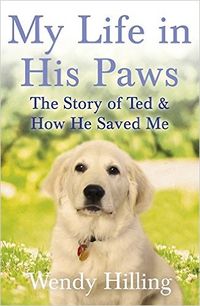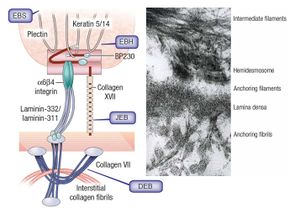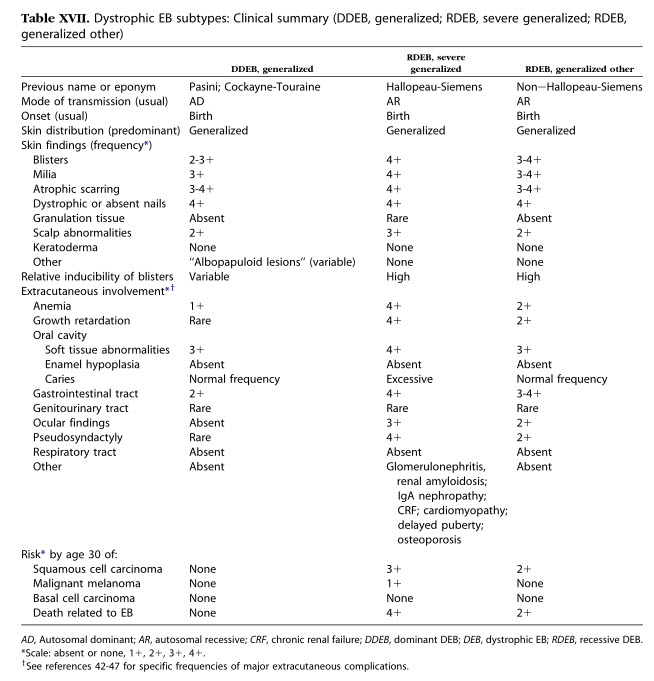Epidermolysis Bullosa
I have a rare genetic skin condition called "epidermolysis bullosa", though its full name is "autosomal recessive dystrophic epidermolysis bullosa, generalized intermediate". This condition means that when my skin is damaged, it heals incompletely leaving it weakened. This is not the classic scar tissue that occurs after deep wounds, but thinner skin that lacks flexibility and is damaged easily. Each time an area is damaged, the new skin is weaker than before. If we break down the full name, it gives a little insight into the condition:
- Epidermolysis Bullosa. (EB) is an umbrella term for genetic skin problems that have blistering as a symptom. The term "Epidermolysis Bullosa" is Latin for 'blistering skin".
- Dystrophic. Epidermolysis Bullosa (DEB) There are three major categories of Epidermolysis Bullosa, and "dystrophic" is the type that results in weakened tissue. The other two categories are "simplex" and "junctional".
- Recessive. Dystrophic Epidermolysis Bullosa (RDEB). Generally, recessive genetic conditions are more serious than dominant, and Dystrophic Epidermolysis Bullosa can be quite horrific.
- Generalized Intermediate. This is the less serious of the two categories of Recessive Dystrophic Epidermolysis Bullosa. There is also a 'generalized severe' variant that is crippling, with a life expectancy in the 30s.
- Under the previous classification, "Generalized Intermediate" was called Non-Hallopeau-Siemens (non-HS RDEB), but this was changed under a reclassification in 2008 (The classification of inherited epidermolysis bullosa (EB): Report of the Third International Consensus Meeting on Diagnosis and Classification of EB)
- Autosomal. A genetic term meaning the gene is not on the sex chromosome.

If you're looking for something more informal, then, check out my sister's book My Life In His Paws which is also a great book for dog lovers. It gives some valuable insight into clicker training, which I believe is by far the best way of training a dog. You may not need to train your dog to unload your washing machine or do the shopping for you, but it's nice to realize the possibilities.
Contents
[hide]1 Details
- DEB is caused by mutations in the COL7A1 gene
- COL7A1 encodes type VII collagen, a major component of the anchoring fibrils
- The anchoring fibrils link the epidermis to the dermis
- Dystrophic epidermolysis bullosa occurs in 6.5 per million newborns in the United States
- Over 400 different mutations of COL7A1 cause DEB
- In HS RDEB there are no anchoring fibrils, creating a life threatening problem. In non-HS RDEB, the anchoring fibrils are present in limited forms.
- COL7A1 gene is located short arm of human chromosome 3, in the chromosomal region denoted 3p21.31. The gene is approximately 31000 base pairs in size at 48,601,505 to 48,632,592
- The epidermis has 4-5 layers, with cells formed at the innermost layer and migrating to the outside over the course of about six weeks.
2 Supposition and incomplete information
- It seems reasonable that blistering in the epidermis would not cause dystrophy scaring.
- There are suggestions that blistering in the epidermis fills with lymph fluid not blood, giving them a clear appearance.
- Some research has looked at Type VII Collagen Injections as a treatment for DEB.
3 Classification of DEB
4 Suggestions for EB sufferers
Over the years I've tried many experiments to try to help with my skin condition. The nature of EB means that there are relatively few things that seem to make a worthwhile difference, but here are some things that have helped me.
- Omega-3. A high intake of Omega 3 oil high seems to make a huge difference to both wound healing and the general condition of my skin. I take both a fish oil supplement and flax oil. For the fish oil I take 1-3 tablespoons of Barlean's Organic Oils Omega Swirl Fish Oil which is in a liquid, rather than capsule form, so it's easier to take a reasonable quantity. I also take around 3 tablespoons of flax oil, putting it into a shake with protein powder and fiber (see below). I've got on well with Nature's Way Flax Oil but you can buy flax oil in bulk at a much lower price. I also work hard to keep my intake of Omega 6 low as this works against Omega 3 in many ways, and generally our diets are high in Omega 6. You find Omega 6 in high quantities in nearly all plant based oils, including nuts.
- Vitamin C. I've been surprised just how much difference high doses of Vitamin C make to my skin. It seems to influence my overall skin health, the rate of wound healing, and the level of scarring. There is research that indicates that it may take several months for the level of Vitamin C to build up in your system. I take 500mg of chewable Vitamin C with 400IU of Vitamin E three times a day, along with a chewable multivitamin.
- Fiber. High levels of Fiber are important for digestive health, and this is particularly important for EB sufferers. I've a suspicion that the fiber also helps my skin in directly, possibly due to the short chain fatty acids that are produced by the intestinal bacteria from digesting parts of the fiber. I take Psyllium Husk Powder mixed in a shake, or Metamucil Sugar Free on its own. I ignored the instructions to drink it quickly, but leave it to absorb the fluid and form a slightly thicker drink. This makes it much less likely to irritate my throat, and reduces any possible risk of choking.
- Protein. Obviously the additional needs of wound healing require an increased protein intake. I drink quite a bit of organic full fat milk which has good protein intake, but I also supplement with a good protein powder. I use Optimum Nutrition 100% Whey Gold Standard.
- Humidity. I've found that while I love the desert, and low humidity environments, my skin is just the opposite. In winter I use a humidifier, which has helped my skin enormously.
- Acid Reflux Medication. I don't have a problem with acid reflux (that I know of), and being an ultrarunner I don't want to mess up my digestive system. However, many EB sufferers take medication like Nexium to prevent acid reflux damaging the throat.
- Detachol. With EB it's easy for tape or an adhesive dressing to pull the skin away on removal. Detachol will deactivate the adhesive and allow the tape or dressing to be easily removed. I've not had any problems with Detachol irritating my skin and the only minor downside is you need to remove it completely before trying to stick anything in it's place.
5 Fellrnr's Shake
This is one of the various shakes I make up, adapted for EB sufferers.
- One scoop of protein powder. I typically use vanilla or chocolate flavor.
- 1 tablespoon of organic cocoa powder, not "Dutch processed" or "processed with alkali" as the processing removes many of the antioxidants.
- 3 tablespoons of organic virgin flax seed oil.
- 1 teaspoon Psyllium Husk Powder.
- 1 tablespoon of Chia seeds, ground just before use. These are a good source of fiber and Omega 3.
- A capsule of green tea extract, with the powder extracted from the open capsule. I'm not sure if this helps my skin or not, but I suspect there are some overall health benefits.
- A little cinnamon or ginger powder for flavor.
- Put the ingredients in a blender, and gradually add milk. Let the mixture stand for a few minutes, repeatedly blending so that the fiber absorbs the fluid.
6 Further Reading for Medical Professionals
Warning - these links contain disturbing images and are recommended for medical professionals only.
- A Case of Non-Hallopeau-Siemens Recessive Dystrophic Epidermolysis Bullosa http://www.ncbi.nlm.nih.gov/pmc/articles/PMC2883369/pdf/ad-21-49.pdf
- What is dystrophic epidermolysis bullosa? http://ghr.nlm.nih.gov/condition/dystrophic-epidermolysis-bullosa
- About EB - http://www.debra.org/modules.php?op=modload&name=News&file=article&sid=18
- Recessive dystrophic epidermolysis bullosa: Presentation of two forms http://dermatology.cdlib.org/143/case_reports/Epidermolysis_Bullosa/medenica.html


